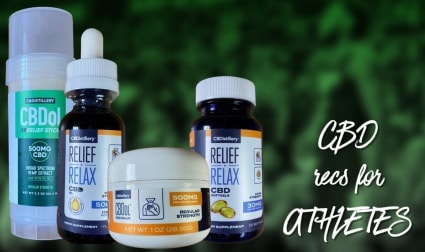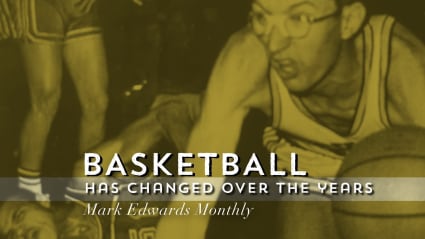The World Anti-Doping Agency (WADA) ended its CBD prohibition just two years ago, one of many signs of the changing narrative surrounding the substance.
CBD and its impact on recovery and fatigue for basketball players has bloomed, with a number of athletes in the sport agreeing to endorsements and otherwise supporting its use. Recently, Nneka Ogwumike of the Los Angeles Sparks became an athlete ambassador for Mendi, joining Sue Bird as the company’s second WNBA spokeswoman. Both players say they use CBD multiple times every day for rest and recovery.
In an interview with Mendi, Ogwumike noted that feelings are changing in the game about CBD.
“I see a vast untapped market … to continue to enhance sport performance, and most importantly, overall well being,” she said.
Earlier this year, BIG3 welcomed CBD into its league with open arms, announcing in January that its fourth season would include an emphasis on the substance’s use. BIG3’s encouragement of its players’ use of CBD came roughly a year after the league made cbdMD an official partner and put its logo on all of its jerseys.
“Last year, BIG3 became the first professional sports league in the U.S. to allow players to use CBD for pain treatment and recovery,” Jeff Kwantinetz, BIG3 co-founder and co-owner, said. “We did this out of compassion for our guys because CBD can help them without enhancing their performance or having an intoxicating effect. It’s a win-win.”
It’s not just current players who have said they’ve tried CBD. Steve Kerr, the current head coach of the Golden State Warriors and former NBA player for 15 years, has said he has tested the substance.
“I guess maybe I can even get in some trouble for this, but I’ve actually tried it twice during the last year and a half, when I’ve been going through this chronic pain that I’ve been dealing with,” he explained on The Warriors Insider Podcast in 2016. “(After) a lot of research, a lot of advice from people and I have no idea if maybe I would have failed a drug test. I don’t even know if I’m subject to a drug test or any laws from the NBA.”
Kerr underwent two back surgeries in 2015, the second to help with pain from the first, but not even those helped. It led him to a four-month leave of absence until he returned to the Warriors sideline in January 2016. It was during that time and through multiple painkilling experiments that he came to the CBD solution.
“I’m not a pot person, it doesn’t agree with me,” the coach admitted. “I’ve tried it a few times, and it did not agree with me at all. So I’m not the expert on this stuff. But I do know this: If you’re an NFL player, in particular, and you’ve got a lot of pain, I don’t think there is any question that pot is better for your body than Vicodin. And yet athletes everywhere are prescribed Vicodin like it’s Vitamin C, like it’s no big deal.”
Kerr brings up a good point, and he’s right. Painkilling meds like Vicodin have been commonplace in the athletic world for some time, and there is no taboo surrounding popping some pills to get through the pain, even if they’re highly addictive. But hit a CBD vape, and until 2018, you were in violation of WADA regulations.
While Kerr might not be a “pot person,” some prominent basketball players haven’t stopped at CBD. John Salley, Al Harrington and Kenyon Martin have all spoken out about widespread marijuana use in the NBA and their own smoking habits, plus the positive effects they’ve experienced for themselves and others. Gary Payton is so heavily involved in the weed business that he has his own strain, and Matt Barnes admitted in 2018 that he smoked before many of his NBA games.
“It wasn’t every single game, but in 15 years, it was a lot,” Barnes told Bleacher Report. “All my best games I was medicated.”
Barnes spoke about weed as part of Bleacher Report’s “B/R x 4/20” special in 2018, along with Harrington. Harrington told his personal experience providing his grandmother with marijuana and what it did for her glaucoma.
“She started crying, crying tears, and she’s like, ‘I’m healed,'” he said. “She’s like, ‘You know I haven’t been able to read the words in my bible in over three years.'”
The two players have also made predictions that the vast majority of the league smokes weed, as well as an “85 percent” estimate from Martin.
There are some distinct differences between CBD and marijuana, though, that are important to understand. Namely, there is a large difference in the psychoactive effects that come from their use.
In cannabis, the THC binds with the brain’s cannabinoid 1 (CB1) receptors, which are mostly found in the central nervous system, impacting the brain and spinal cord. This provides the high and euphoric feelings associated with weed. CBD, meanwhile, barely binds with CB1 receptors, if at all. The THC in marijuana is necessary for that, and CBD lacks it.
Instead, CBD links more with cannabinoid 2 (CB2) receptors, which are more prominent in the peripheral nervous system, which influences the rest of your body. Therefore, CBD works more to reduce inflammation rather than give the high cannabis does.
Both CBD and THC have the same atoms – 30 hydrogen atoms, 21 carbon atoms and two oxygen atoms – but how they’re arranged is the cause for their main dissimilarity.
“Because of that, it’s a wildly different key going into the lock,” Jeffrey Raber, CEO of The Werc Shop, a cannabis chemistry lab, told Morgan Sung of Mashable in 2019.
That is a pretty big difference, and the one that often drives which substance a person prefers. It is also possible to find products that mix both CBD and THC together, giving the user a combination of effects.
CBD and THC both interact with a person’s cannabidoid receptors, though, which is why they can each bring positive influences. THC is more commonly used for sleep, appetite, relaxation and euphoria, while CBD is typically more for battling seizures, inflammation and depression. However, THC helps some people with their depression, and both substances can aid with nausea, pain and anxiety.
The anti-inflammatory properties in CBD make sense for athletes looking for help with pain and recovery from injury, and the stress that high-level athletics can place on someone can help be alleviated through its use. More and more athletes have opened up about their use of CBD and marijuana, and basketball is no exception. It appears that this may be the next revolution in sports science that helps produce the next generation of super athlete.
—

Just a few of the many products pro basketball players are using to maintain their best selves include:
#1 Full-Spectrum 500mg CBD Oil
The product most often called CBD oil is a blend of hemp extract and a carrier oil, a tincture. This tincture is a medium strength product that works well for many players. CBD tinctures are easy to use; simply place the oil under your tongue and hold a few seconds before swallowing.
#2 CBDol 500mg Relief Stick
CBD products are ideal for rubbing down muscles after a grueling game or strenuous workout. CBDistillery™ CBDol Relief Stick gives you an instant sensation from the menthol, and it couldn’t be easier to use and then toss in a locker or duffle to get back on the move.
#3 CBD 30mg Nighttime Gummies
With games starting at 7 p.m. or later, players aren’t even getting back to their beds until midnight on some game days. Having a way to boost physical recovery while getting players to much needed sleep quicker is clutch. Sometimes it’s just easier to chew up a little snack before bed and having a little dose of melatonin added to the gummies really helps sweeten the deal.
It’s the same ideas at the Relief Stick, but more adaptable to wherever you need to apply it. CBDol topicals are focused on providing localized relief to aid those nagging spot in recovery.
Probably the easiest way to get your dose of CBD is down the old hatch. No bad taste, easy to handle after a game, Soft Gels are a solid choice for starting that recovery process.
Editor’s Note: This content is powered by LaxAllStars.com partner CBDistillery, a leader in the industry.







